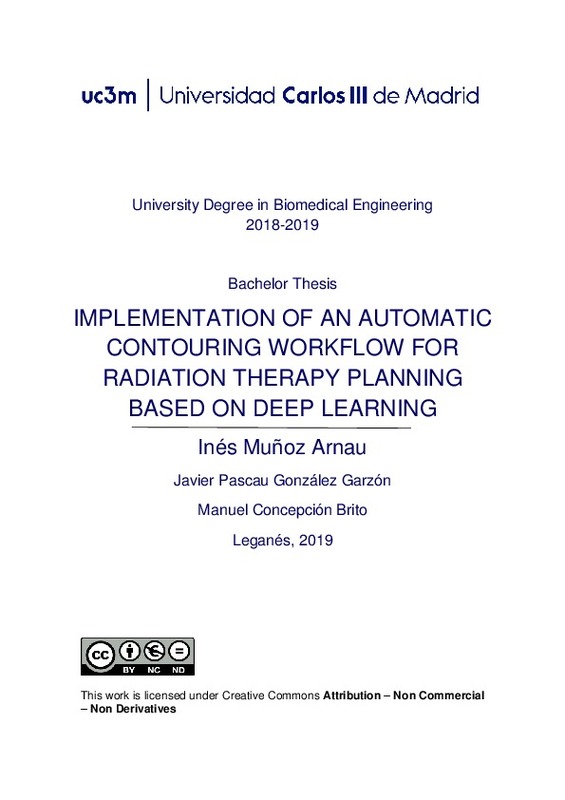JavaScript is disabled for your browser. Some features of this site may not work without it.
Buscar en RiuNet
Listar
Mi cuenta
Estadísticas
Ayuda RiuNet
Admin. UPV
DESARROLLO DE UN FLUJO DE TRABAJO AUTOMÁTICO PARA LA PLANIFICACIÓN EN ONCOLOGÍA RADIOTERÁPICA BASADO EN DEEP LEARNING
Mostrar el registro sencillo del ítem
Ficheros en el ítem
| dc.contributor.advisor | Verdú Martín, Gumersindo Jesús
|
es_ES |
| dc.contributor.advisor | Pascau Gonzalez-Garzon, Javier
|
es_ES |
| dc.contributor.author | Muñoz Arnau, Inés
|
es_ES |
| dc.date.accessioned | 2020-07-02T15:01:42Z | |
| dc.date.available | 2020-07-02T15:01:42Z | |
| dc.date.created | 2020-06-03 | |
| dc.date.issued | 2020-07-02 | es_ES |
| dc.identifier.uri | http://hdl.handle.net/10251/147344 | |
| dc.description.abstract | [ES] El cáncer de cabeza y cuello es el sexto más común en el mundo. Se trata de un grupo de tumores malignos que surgen en la región de la cabeza o el cuello. El tratamiento de este tipo de enfermedad requiere de muchos especialistas y, a veces, de diversas técnicas, entre las que se incluyen la cirugía, la quimioterapia y la radioterapia. La radioterapia consiste en el uso de radiación ionizante para el tratamiento de enfermedades malignas. Su ventaja es que conserva el órgano y, a veces, su función. En la planificación del tratamiento, se necesita una delineación de los órganos en riesgo. Este proceso se realiza de forma manual, por lo que requiere mucho tiempo y es poco práctico para los flujos de trabajo de radioterapia. Requiere una segmentación de las estructuras en cada corte de las imágenes de TAC. En los últimos años, se han llevado a cabo varias investigaciones en el campo biomédico para el análisis de imágenes y ayuda al diagnóstico, y se han realizado investigaciones sobre segmentaciones automáticas desde varios enfoques. Sin embargo, la implementación de modelos de aprendizaje profundo requiere la instalación de numerosas bibliotecas y marcos que hacen que sea muy difícil integrarlos en el flujo de trabajo clínico, lo que genera una brecha entre el estado del arte y la praxis real. Esta tesis es un enfoque de cómo integrar una herramienta basada en el aprendizaje profundo en el servicio de radioterapia para la segmentación automática de órganos de riesgo en tumores de cabeza y cuello. Para ese propósito, tenemos el entorno de Slicer (una aplicación para análisis de imágenes médicas), todas sus bibliotecas para ejecutar un modelo de deep learning y contenedores Docker. | es_ES |
| dc.description.abstract | [EN] Head and neck cancer is the sixth most common in the world. It refers to a group of malignant tumors that arise in the head or neck region. Treatment decisions involve many specialists and sometimes various techniques, among which are surgery, chemotherapy and radiation therapy. Radiation therapy consists on the use of ionizing radiation for the treatment of malign diseases. Its advantage is that it preserves the organ and, sometimes, the function. In the planning for the treatment, a delineation of the organs at risk is needed. This process is done manually and it is time-consuming and impractical for radiotherapy workflows. It requires outlining of structures slice by slice in CT images. In recent years, several investigations have been carried out in the biomedical field for image analysis and diagnosis help, and research into automatic segmentations has been made on different approaches. However, implementing deep learning models require the installation of numerous libraries and frameworks that make it very difficult to integrate them in the clinical workflow, causing a gap between the state-of-the-art and the real praxis. This thesis is an approach of how to integrate a deep-learning-based tool in the radiotherapy service for automatic delineation of organs at risk in head and neck tumors. For that purpose, we have the Slicer environment (an application for medical analysis), all its libraries to run a deep learning model and Docker containers. | es_ES |
| dc.format.extent | 0 | es_ES |
| dc.language | Inglés | es_ES |
| dc.publisher | Universitat Politècnica de València | es_ES |
| dc.rights | Reconocimiento - No comercial - Sin obra derivada (by-nc-nd) | es_ES |
| dc.subject | Radioterapia | es_ES |
| dc.subject | Aprendizaje profundo | es_ES |
| dc.subject | Segmentación | es_ES |
| dc.subject | Flujo automático | es_ES |
| dc.subject | Slicer | es_ES |
| dc.subject | Docker | es_ES |
| dc.subject | Radiotherapy | es_ES |
| dc.subject | Deep Learning | es_ES |
| dc.subject | Contouring | es_ES |
| dc.subject | Automatic workflow | es_ES |
| dc.subject.classification | INGENIERIA NUCLEAR | es_ES |
| dc.subject.other | Grado en Ingeniería Biomédica-Grau en Enginyeria Biomèdica | es_ES |
| dc.title | DESARROLLO DE UN FLUJO DE TRABAJO AUTOMÁTICO PARA LA PLANIFICACIÓN EN ONCOLOGÍA RADIOTERÁPICA BASADO EN DEEP LEARNING | es_ES |
| dc.type | Proyecto/Trabajo fin de carrera/grado | es_ES |
| dc.rights.accessRights | Abierto | es_ES |
| dc.contributor.affiliation | Universitat Politècnica de València. Departamento de Proyectos de Ingeniería - Departament de Projectes d'Enginyeria | es_ES |
| dc.contributor.affiliation | Universitat Politècnica de València. Escuela Técnica Superior de Ingenieros Industriales - Escola Tècnica Superior d'Enginyers Industrials | es_ES |
| dc.description.bibliographicCitation | Muñoz Arnau, I. (2020). DESARROLLO DE UN FLUJO DE TRABAJO AUTOMÁTICO PARA LA PLANIFICACIÓN EN ONCOLOGÍA RADIOTERÁPICA BASADO EN DEEP LEARNING. http://hdl.handle.net/10251/147344 | es_ES |
| dc.description.accrualMethod | TFGM | es_ES |
| dc.relation.pasarela | TFGM\112804 | es_ES |
Este ítem aparece en la(s) siguiente(s) colección(ones)
-
ETSII - Trabajos académicos [10404]
Escuela Técnica Superior de Ingenieros Industriales






